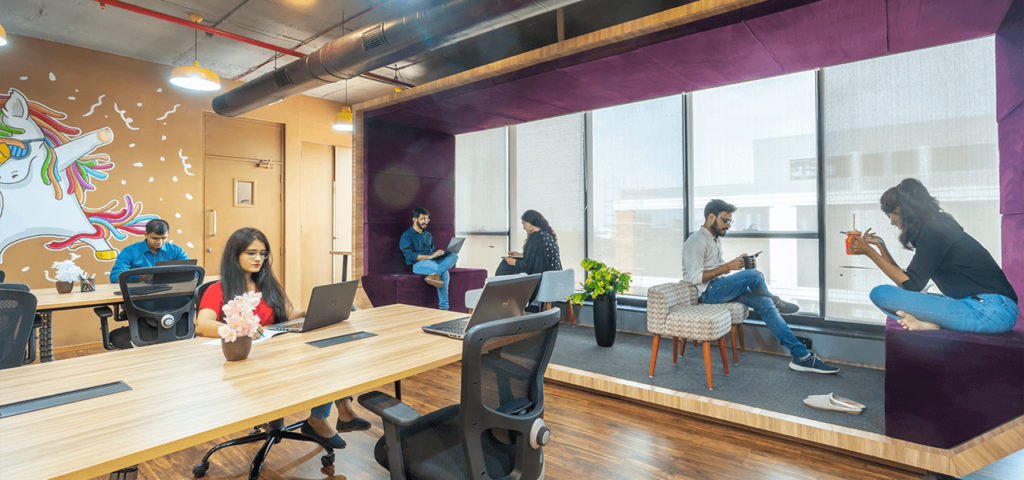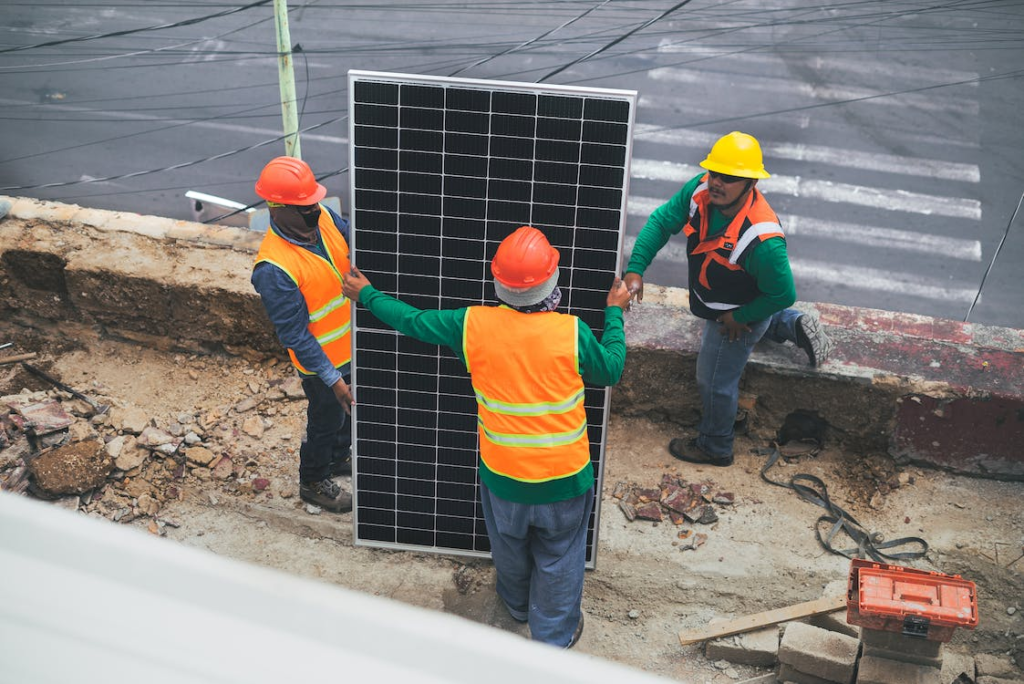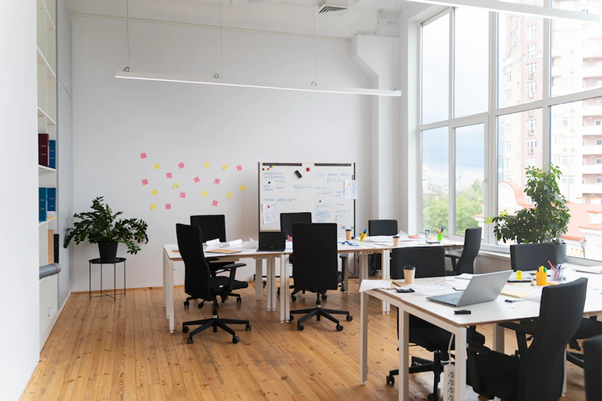As the name suggests, a co-working space is a space where people from different companies work together. It is a shared office space among various companies and freelancers.
The term co-working was first used by Bernard DeKoven, who described it as people working together as equals. It was a concept where people working for different employers or freelancers could share their ideas and work together. So, initially, the term co-working or an office on rent was not about using a shared space, but it referred to a type of collaboration.

Photo Credits: DevX
The idea of a regular corporate office changed by leaps and bounds when Facebook and Google ditched the usual designs and invested in creating swanky offices. Soon, the startups followed, and the world saw that a cubicle was unnecessary for a workplace.
The origin of the first managed office dates back to 1995 in Berlin, Germany. It was called Hackerspace, as it was founded by hackers to share knowledge and space and work on coding projects together. Soon similar places followed, but the first proper co-working space was the San Francisco Coworking Space. It was established in 2005, had a few desks, offered free WiFi, a shared lunch system, and collective bike rides, and closed before 6 pm. By 2016, corporate giants like KPMG, Microsoft, HSBC, and IBM had their employees working from co-working spaces. In 2020 the pandemic struck, and there was no looking back.
All was going well before the pandemic struck. The offices shut down, and the world began working from home. The offices were shut, and working from home was a necessity. This opened the employees minds to a new dimension because people discovered that remote work was not merely a possibility but also super convenient. Even after the governments relaxed the restrictions, the offices remained shut. People started going to cafes and bars to work, which paved the way for multiple co-working spaces to be established in various cities.
Various people also started freelancing after the pandemic as it meant setting their schedule, working for themselves, and, most importantly, on their own time. Companies were losing much money on rent, and sharing offices seemed practical. Together, these factors paved the way for the rise of co-working spaces.
Often seen as a fantastic concept, co-working has a few drawbacks. They are as follows:
- Lack of Privacy
The design of co-working spaces varies significantly from a regular office. While the usual corporate office has cubicles and cabins, co-working spaces have open desks and other open-for-all areas that anyone can work in. The concept of privacy is far-fetched while working in co-working spaces.
- Lack of Exclusivity
Most co-working spaces involve people from various companies or freelancers working in the same room. Unlike an office, there exists no exclusivity for the members of co-working spaces. All areas are equally accessible to the members.
- Seemingly Unprofessional Image
A company with a properly registered office is viewed as more professional in its approach than one which works from a workspace. The flexible timings and the simple process of co-working spaces may make a person or a company look unprofessional.
- Office-Like Problems
Co-working may be different from working in a proper corporate office, but it has its set of office-like problems. One has to wake up on time, get dressed appropriately, and commute to work and back. You may not be in a remote job after all, and you feel more tired due to all the hassle.
- Not a Real Office
As much work as a person may do from co-working spaces, the reality is that it is not an office in its true essence. It needs to have the formal appeal and the feel where multiple employees come together to work towards achieving the same goal.
That being said, co-working spaces are pretty good. They also have multiple benefits and hold much value for people working remote jobs. They provide people with a sweet spot where people get to work remotely and still get to leave the house and not be stuck while working at home.
The Benefits of Co-Working Spaces
There exist various benefits of working in co-working spaces. They are as follows:
Reduced Expenses: Co-Working involves companies coming together and sharing office space. The sharing of office space entails sharing other aspects like rent, electricity, water, and other expenses. When multiple entities share fixed and recurring expenses, it costs them less than having an entire office.
- Minimal Wastage of Resources
Sharing an office space helps minimize the wastage of various resources. Individual offices collectively consume more resources but when people come together in a shared space, they use the same resources collectively. The entire area is used, and other resources like electricity and water are not wasted.
- Flexible Work Hours
Various companies are based in one country and employ people in other countries. This makes for different work timings as people work in separate time zones. Shared offices like co-working spaces are also used by freelancers who might have clients in other countries. Co-working spaces thus give people the to work flexibly.
- Enhanced Productivity
Working from home involves many distractions, like crying babies, loud neighbors, and high-maintenance pets. Working in a co-working space provides an office-like environment. It enhances employee productivity as it moves them away from all the distractions of home.
- Increased Networking
One of the many benefits of co-working includes increased networking. You end up meeting and interacting with people from various fields working in the same space as you. Also, they might introduce you to others, allowing you to expand your network.
- Work-Life Balance
Striking a balance between work and personal life is one of the biggest challenges a person’s faces while working from home. Using a co-working space for work while you work remotely eases that option for you. You can allow a specific number of hours to your work time and create a balance between work and personal time.
- Break the Monotony
Working at home has its disadvantages. Unless You have a dedicated workspace studio at home, it is a very tiresome process. Going to a co-working space breaks the monotony of being at home 24X7. It gives you a separate area to work and gets the productive juices of the brain flowing.
Sustainable and Eco-Friendly
Working in a co-working space is a step towards living sustainably and incorporating eco-friendliness. A shared space helps you interact with more working individuals, significantly reduces recurring expenses, and helps conserve energy.
The benefits of sustainability and eco-friendliness in one’s life are no secret. There are multiple advantages to living a sustainable and eco-friendly life. Reducing the use of plastic, conserving resources, and minimizing wastage are a few steps one may take to live sustainably. Not just that, but now you can introduce sustainability and eco-friendliness to a co-working space. Please continue reading to find out more about it!
The Correlation Between Sustainability and Eco-Friendliness
People often use the terms sustainable and eco-friendly in the same sentence, making it seem like we can interchange the two words. They may appear synonymous with each, but in reality, they are not.
A product must meet three criteria for it to be classified as sustainable. It has to be socially, economically, and environmentally beneficial. So, a sustainable product is accessible in the pocket, benefits society, and does not harm the environment.
An eco-friendly product, on the other hand, is a product that does not harm the environment. By that logic, we may infer that all sustainable products are eco-friendly, but all eco-friendly products may not be sustainable. But for convenience, the two terms are primarily used together and interchangeably.
The world is forever changing, and so are the terms. With developments around the world, the definitions for many things keep changing. For example, a phone in the 1950s meant a telephone with a wire; today, it represents a mobile phone in general and includes a wired telephone.
Similarly, the definition of sustainable design keeps changing. However, the National Institute of Building Sciences, USA, has defined the six fundamental principles of sustainable design, namely:
- Optimized Site Potential
- Optimized Energy Use
- Protection and Conservation of Water
- Optimized Building Space and Material Use
- Enhanced Indoor Environmental Quality (IEQ)
- Optimized Operational and Maintenance Practices
A building design inclusive of the abovementioned principles would be sustainable. Let us dig deeper into what role these principles play in co-working spaces.
- Optimize Site Potential
A successful project in sustainable construction(new or renovation) begins with selecting a good site and then aligning the site design with a sustainable one.
The local ecosystem of a place is affected by multiple factors like its location, landscape, modes of transportation, and energy used around it.
A sustainable design is supposed to support the native flora and fauna of the region around the site. When a site is optimized to its potential, it does not mess up the local ecosystem of the region it is located in. This creates a positive impact on the minds of people in a co-working space and helps them put their complete focus on work and enhance their productivity.
- Optimized Energy Use

Photo Credits: Los Muertos Crew
Incorporating a design that has optimized its use of energy brings the design model close to sustainability. Suppose the power used in and after construction is sustainable. In that case, the building gets one step closer to achieving sustainability.
Our energy independence may be increased by improving the energy performance of existing buildings. The energy we conventionally use largely depends on fossil fuels, a non-renewable resource. Moving towards other renewable energy sources, like solar energy, brings you closer to sustainability.
The companies or freelancers that come together and work in a co-working space can save a lot on energy use and expenses instead of working in separate units that would end up using more energy, which in turn cuts down on costs and leaves more scope for earning profit for the companies and the freelancers.
- Protect and Conserve Water
Water scarcity is absolute and has been an issue for quite some time. A sustainable building design and construction uses water efficiently and minimizes wastage. It is an added advantage when there is a scope for recycling the water at the site.
Multiple companies and freelancers come together when they use a co-working space. This helps with the efficient use of water as the water is not being used in various offices and also minimizes water wastage. Similarly, the water bill is shared between the people utilizing the co-working space, which helps cut down the expenses a person would typically incur while working separately.
- Optimized Building Space and Material Use
The world population has been growing continuously, which has caused the demand and the use of natural resources to rise simultaneously. A building with a sustainable design uses the raw materials used in the facility’s construction efficiently and adequately uses the building space.
Using eco-friendly and sustainable products help with various environmental issues like global warming, overuse of resources, pollution, etc. People working in a co-working space already save much waste of material, construction, and otherwise. It is an added advantage when these buildings are constructed with eco-friendly materials. The disposal costs and other liabilities are much less in the construction of co-working spaces for the reasons mentioned above.
- Enhanced Indoor Environmental Quality (IEQ)
The indoor environmental quality (IEQ) of a building significantly impacts the health, comfort, and productivity of the occupants. A building with a good IEQ is a sustainable building. The design of the building offers ample daylight and proper ventilation, is not prone to moisture, and uses materials with high-VOC emissions that are avoided in the building.
Co-working spaces are very unlike regular corporate offices. They do not have cubicles. So one does not feel restricted in a small area the whole day. Particular emphasis is given to ventilation and natural lighting to incorporate a positive environment. Co-working spaces can thus have an enhanced IEQ and qualify as sustainable workplaces. The natural lighting and ventilation keep a positive attitude amongst the people working there, and the low VOC emissions keep them healthy, adding to employee productivity.
- Optimized Maintenance and Operational Practices
A building is considered sustainable when its operational and maintenance practices are optimized. The builders may use materials that simplify operations and require less care. These involve ensuring the conservation of energy, minimum wastage of water, etc.
Co-working spaces are mostly built after considering these factors. They are made to be simple to avoid any maintenance hassles. This, too, saves money for the company and the freelancers working in a co-working space.
Co-working thus leads to sustainability and eco-friendliness when it considers the six principles of sustainable construction. Sustainability and eco-friendliness, therefore, play an essential role in a co-working space.
They help save money by cutting unnecessary expenses, providing a positive environment, and making the workers feel they are doing their bit to save the planet. Co-working spaces help minimize the wastage of energy, water, etc. They are a great way of balancing commercial activities without much wastage. Thus, they are socially, economically, and environmentally beneficial to the planet and have sustainability play a vital part in co-working spaces or buildings.




Wow, wonderful weblog structure! How long have you ever been blogging for?
you make running a blog glance easy. The total look
of your web site is excellent, as well as the content!
You can see similar here sklep online